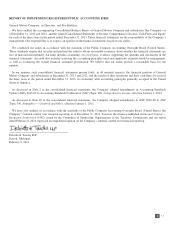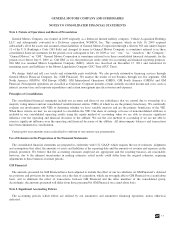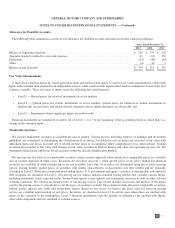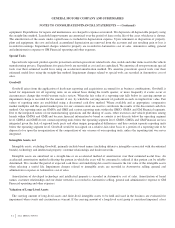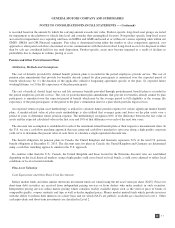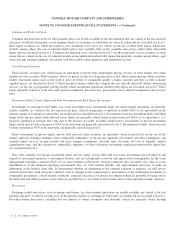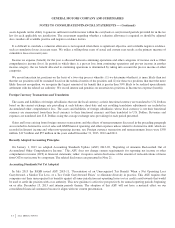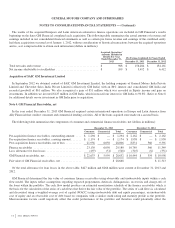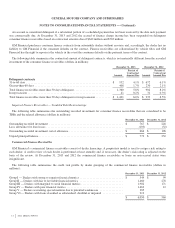General Motors 2013 Annual Report Download - page 65
Download and view the complete annual report
Please find page 65 of the 2013 General Motors annual report below. You can navigate through the pages in the report by either clicking on the pages listed below, or by using the keyword search tool below to find specific information within the annual report.
GENERAL MOTORS COMPANY AND SUBSIDIARIES
NOTES TO CONSOLIDATED FINANCIAL STATEMENTS — (Continued)
Inventory
Inventories are stated at the lower of cost or market. Market, which represents selling price less cost to sell, considers general
market and economic conditions, periodic reviews of current profitability of vehicles, product warranty costs and the effect of current
and expected incentive offers at the balance sheet date. Market for off-lease and other vehicles is current auction sales proceeds less
disposal and warranty costs. Productive material, work in process, supplies and service parts are reviewed to determine if inventory
quantities are in excess of forecasted usage or if they have become obsolete.
Equipment on Operating Leases, net
Equipment on operating leases, net is reported at cost, less accumulated depreciation, net of origination fees or costs, and lease
incentives. Estimated income from operating lease assets, which includes lease origination fees, net of lease origination costs, is
recorded as operating lease revenue on a straight-line basis over the term of the lease agreement. Leased vehicles are depreciated on a
straight-line basis to an estimated residual value over the term of the lease agreements.
We have significant investments in vehicles in operating lease portfolios, which are composed of vehicle leases to retail customers
with lease terms of up to 60 months and vehicles leased to rental car companies with lease terms that average eight months or less. We
are exposed to changes in the residual values of those assets. For impairment purposes the residual values represent estimates of the
values of the vehicles leased at the end of the lease contracts and are determined based on forecasted auction proceeds when there is a
reliable basis to make such a determination. Realization of the residual values is dependent on the future ability to market the vehicles
under the prevailing market conditions. The adequacy of the estimate of the residual value is evaluated over the life of the lease and
adjustments may be made to the extent the expected value of the vehicle at lease termination changes. Adjustments may be in the
form of revisions to the depreciation rate or recognition of an impairment charge. Impairment is determined to exist if the expected
future cash flows, which include estimated residual values, are lower than the carrying amount of the vehicles leased. If the carrying
amount is considered impaired, an impairment charge is recorded for the amount by which the carrying amount exceeds the fair value.
Fair value is determined primarily using the anticipated cash flows, including estimated residual values.
In our Automotive operations when a leased vehicle is returned the asset is reclassified from Equipment on operating leases, net to
Inventories at the lower of cost or estimated selling price, less cost to sell. In our Automotive Finance operations when a leased
vehicle is returned or repossessed the asset is recorded in Other assets at the lower of cost or estimated selling price, less costs to sell.
Upon disposition a gain or loss is recorded for any difference between the net book value of the leased asset and the proceeds from the
disposition of the asset.
Impairment charges related to Equipment on operating leases, net are recorded in Automotive cost of sales or GM Financial
operating and other expenses.
Valuation of Cost and Equity Method Investments
When events and circumstances warrant, investments accounted for under the cost or equity method of accounting are evaluated for
impairment. An impairment charge is recorded whenever a decline in value of an investment below its carrying amount is determined
to be other-than-temporary. In determining if a decline is other-than-temporary, factors such as the length of time and extent to which
the fair value of the investment has been less than the carrying amount of the investment, the near-term and longer-term operating and
financial prospects of the affiliate and the intent and ability to hold the investment for a period of time sufficient to allow for any
anticipated recovery are considered. Impairment charges related to equity method investments are recorded in Equity income and gain
on investments. Impairment charges related to cost method investments are recorded in Interest income and other non-operating
income, net.
Property, net
Property, plant and equipment, including internal use software, is recorded at cost. Major improvements that extend the useful life
or add functionality of property are capitalized. The gross amount of assets under capital leases is included in property, plant and
63


